Early Childhood Education
VerifiedAdded on 2023/03/23
|8
|1513
|66
AI Summary
This paper covers questions related to early childhood education, including essential attributes for teachers, roles of teachers, observation in early childhood settings, and the use of ICT tools in ECE. It also discusses the concept of pedagogy and the importance of self-esteem in early childhood education.
Contribute Materials
Your contribution can guide someone’s learning journey. Share your
documents today.
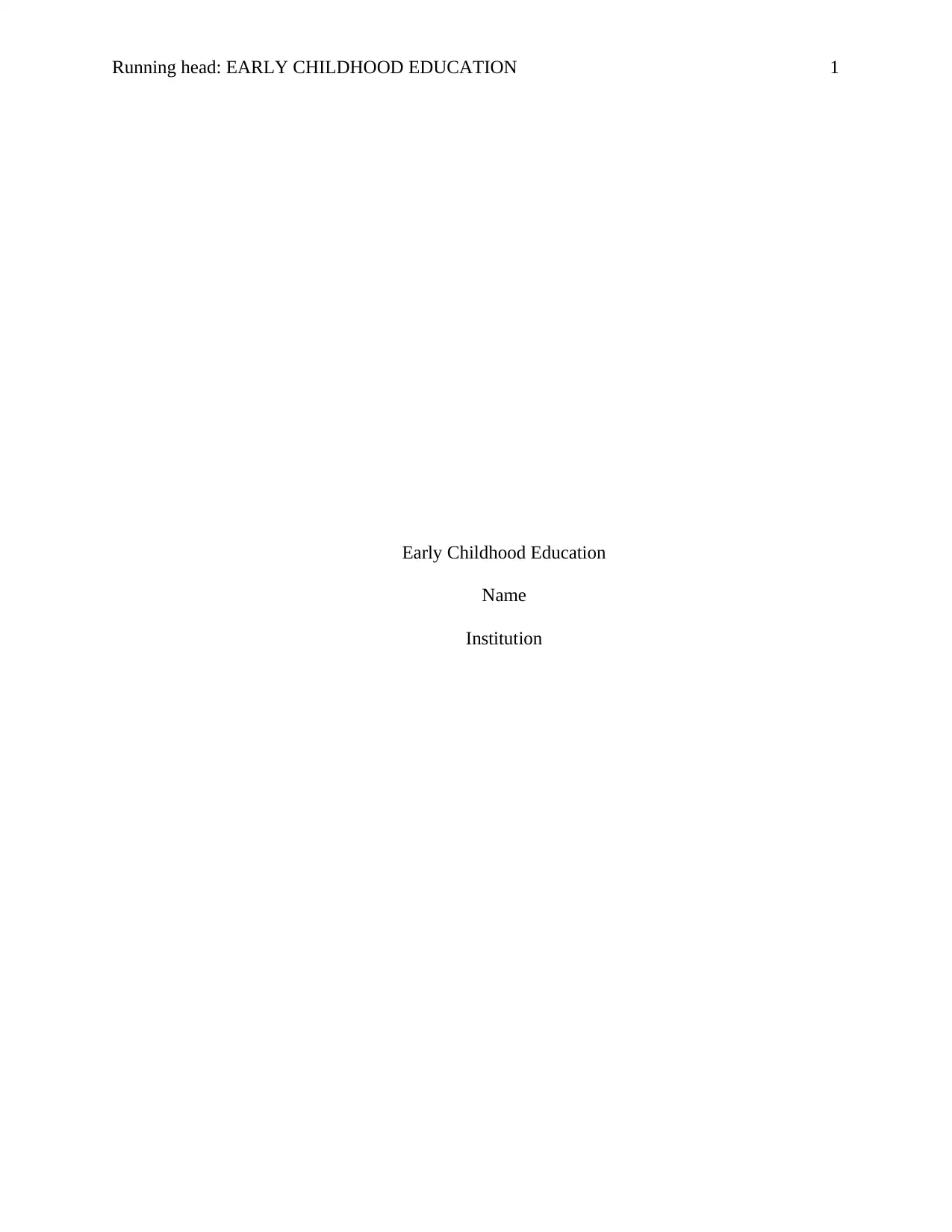
Running head: EARLY CHILDHOOD EDUCATION 1
Early Childhood Education
Name
Institution
Early Childhood Education
Name
Institution
Secure Best Marks with AI Grader
Need help grading? Try our AI Grader for instant feedback on your assignments.

EARLY CHILDHOOD EDUCATION 2
EARLY CHILDHOOD EDUCATION
Introduction
This paper contains a set of questions that cover issues linked to early childhood
education. ECE deals with the teaching of young children.
Quiz 1
Some of the essential attributes that a teacher should possess are Humor and Patience,
communication skills, creativity, and flexibility. According to many researchers, the essential
feature for educators for young children is enthusiasm as well as a passion for children (Benekos,
2016). Teachers need to develop excellent communication skills to enable them to communicate
well with both the children and their parents (Voogt & McKenney, 2017). A teacher will have to
communicate with the parents of the child about his/her skills, needs, achievements and
problems.
Quiz 2
According to me, the most important roles of teachers include:
Creation of classroom environment: Most of the teachers help in preparing a
comfortable, warm environment. This environment always makes learners happy.
Teaching knowledge: The most critical role that a teacher plays is to impart knowledge to
young children. Teachers may use different ways to teach young children including small group
activities and lectures.
EARLY CHILDHOOD EDUCATION
Introduction
This paper contains a set of questions that cover issues linked to early childhood
education. ECE deals with the teaching of young children.
Quiz 1
Some of the essential attributes that a teacher should possess are Humor and Patience,
communication skills, creativity, and flexibility. According to many researchers, the essential
feature for educators for young children is enthusiasm as well as a passion for children (Benekos,
2016). Teachers need to develop excellent communication skills to enable them to communicate
well with both the children and their parents (Voogt & McKenney, 2017). A teacher will have to
communicate with the parents of the child about his/her skills, needs, achievements and
problems.
Quiz 2
According to me, the most important roles of teachers include:
Creation of classroom environment: Most of the teachers help in preparing a
comfortable, warm environment. This environment always makes learners happy.
Teaching knowledge: The most critical role that a teacher plays is to impart knowledge to
young children. Teachers may use different ways to teach young children including small group
activities and lectures.
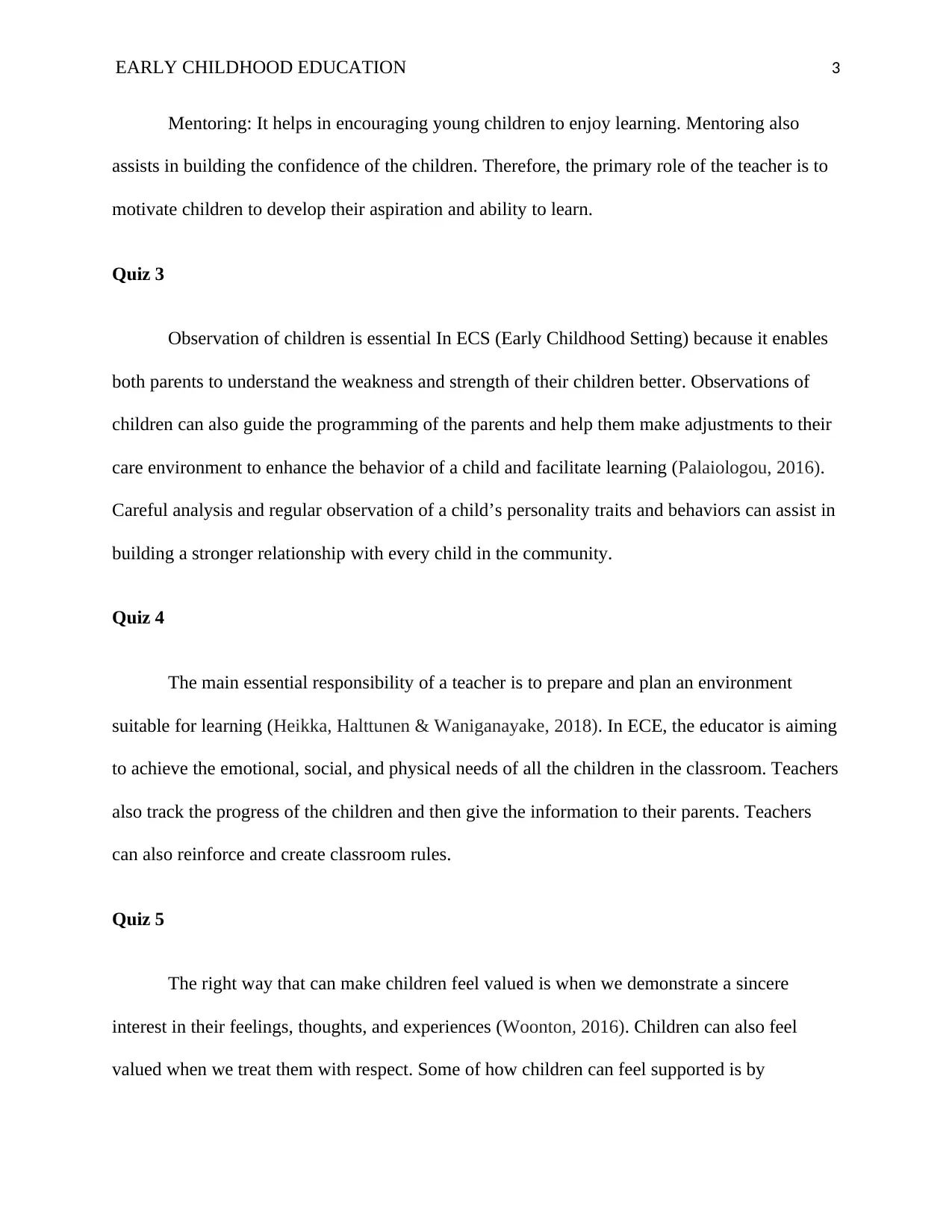
EARLY CHILDHOOD EDUCATION 3
Mentoring: It helps in encouraging young children to enjoy learning. Mentoring also
assists in building the confidence of the children. Therefore, the primary role of the teacher is to
motivate children to develop their aspiration and ability to learn.
Quiz 3
Observation of children is essential In ECS (Early Childhood Setting) because it enables
both parents to understand the weakness and strength of their children better. Observations of
children can also guide the programming of the parents and help them make adjustments to their
care environment to enhance the behavior of a child and facilitate learning (Palaiologou, 2016).
Careful analysis and regular observation of a child’s personality traits and behaviors can assist in
building a stronger relationship with every child in the community.
Quiz 4
The main essential responsibility of a teacher is to prepare and plan an environment
suitable for learning (Heikka, Halttunen & Waniganayake, 2018). In ECE, the educator is aiming
to achieve the emotional, social, and physical needs of all the children in the classroom. Teachers
also track the progress of the children and then give the information to their parents. Teachers
can also reinforce and create classroom rules.
Quiz 5
The right way that can make children feel valued is when we demonstrate a sincere
interest in their feelings, thoughts, and experiences (Woonton, 2016). Children can also feel
valued when we treat them with respect. Some of how children can feel supported is by
Mentoring: It helps in encouraging young children to enjoy learning. Mentoring also
assists in building the confidence of the children. Therefore, the primary role of the teacher is to
motivate children to develop their aspiration and ability to learn.
Quiz 3
Observation of children is essential In ECS (Early Childhood Setting) because it enables
both parents to understand the weakness and strength of their children better. Observations of
children can also guide the programming of the parents and help them make adjustments to their
care environment to enhance the behavior of a child and facilitate learning (Palaiologou, 2016).
Careful analysis and regular observation of a child’s personality traits and behaviors can assist in
building a stronger relationship with every child in the community.
Quiz 4
The main essential responsibility of a teacher is to prepare and plan an environment
suitable for learning (Heikka, Halttunen & Waniganayake, 2018). In ECE, the educator is aiming
to achieve the emotional, social, and physical needs of all the children in the classroom. Teachers
also track the progress of the children and then give the information to their parents. Teachers
can also reinforce and create classroom rules.
Quiz 5
The right way that can make children feel valued is when we demonstrate a sincere
interest in their feelings, thoughts, and experiences (Woonton, 2016). Children can also feel
valued when we treat them with respect. Some of how children can feel supported is by
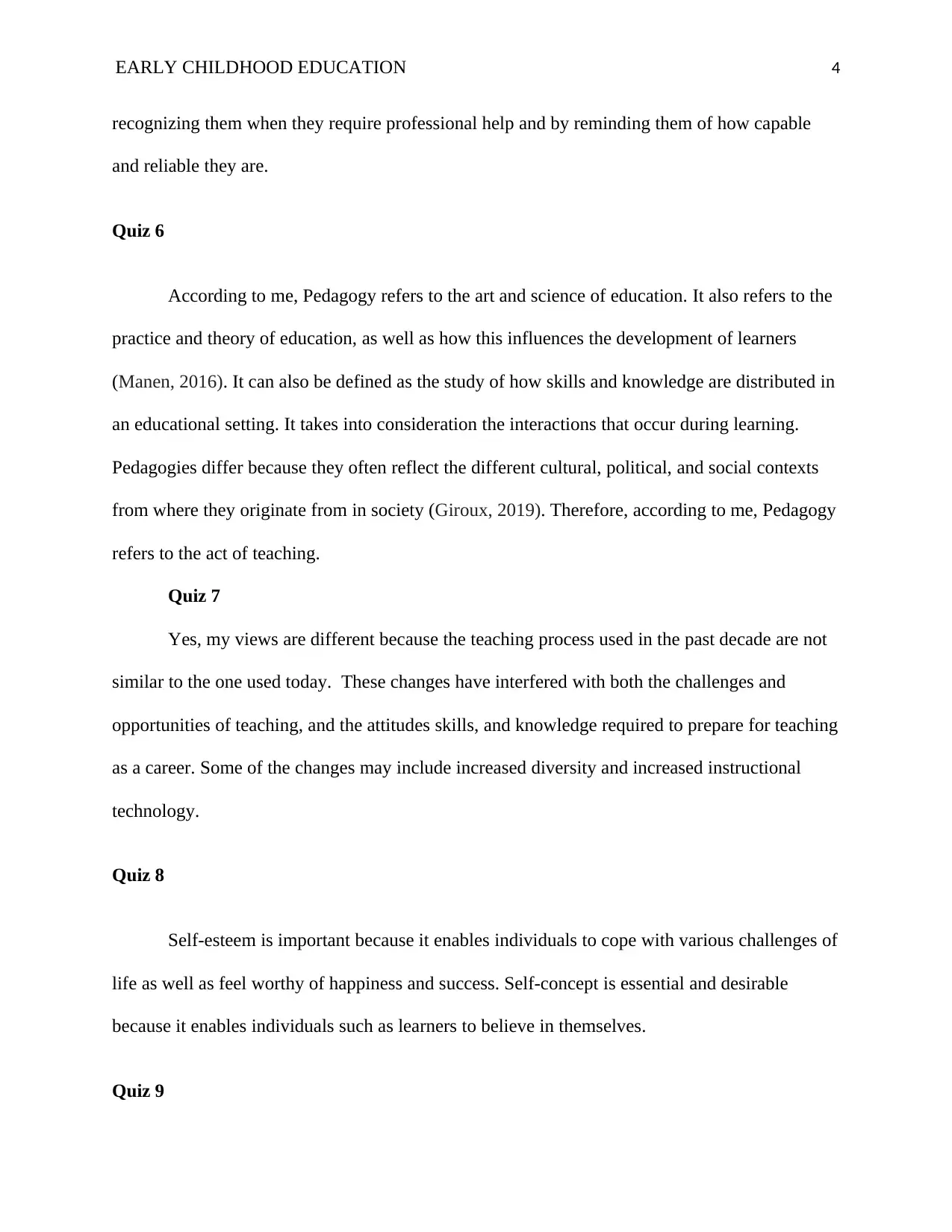
EARLY CHILDHOOD EDUCATION 4
recognizing them when they require professional help and by reminding them of how capable
and reliable they are.
Quiz 6
According to me, Pedagogy refers to the art and science of education. It also refers to the
practice and theory of education, as well as how this influences the development of learners
(Manen, 2016). It can also be defined as the study of how skills and knowledge are distributed in
an educational setting. It takes into consideration the interactions that occur during learning.
Pedagogies differ because they often reflect the different cultural, political, and social contexts
from where they originate from in society (Giroux, 2019). Therefore, according to me, Pedagogy
refers to the act of teaching.
Quiz 7
Yes, my views are different because the teaching process used in the past decade are not
similar to the one used today. These changes have interfered with both the challenges and
opportunities of teaching, and the attitudes skills, and knowledge required to prepare for teaching
as a career. Some of the changes may include increased diversity and increased instructional
technology.
Quiz 8
Self-esteem is important because it enables individuals to cope with various challenges of
life as well as feel worthy of happiness and success. Self-concept is essential and desirable
because it enables individuals such as learners to believe in themselves.
Quiz 9
recognizing them when they require professional help and by reminding them of how capable
and reliable they are.
Quiz 6
According to me, Pedagogy refers to the art and science of education. It also refers to the
practice and theory of education, as well as how this influences the development of learners
(Manen, 2016). It can also be defined as the study of how skills and knowledge are distributed in
an educational setting. It takes into consideration the interactions that occur during learning.
Pedagogies differ because they often reflect the different cultural, political, and social contexts
from where they originate from in society (Giroux, 2019). Therefore, according to me, Pedagogy
refers to the act of teaching.
Quiz 7
Yes, my views are different because the teaching process used in the past decade are not
similar to the one used today. These changes have interfered with both the challenges and
opportunities of teaching, and the attitudes skills, and knowledge required to prepare for teaching
as a career. Some of the changes may include increased diversity and increased instructional
technology.
Quiz 8
Self-esteem is important because it enables individuals to cope with various challenges of
life as well as feel worthy of happiness and success. Self-concept is essential and desirable
because it enables individuals such as learners to believe in themselves.
Quiz 9
Secure Best Marks with AI Grader
Need help grading? Try our AI Grader for instant feedback on your assignments.
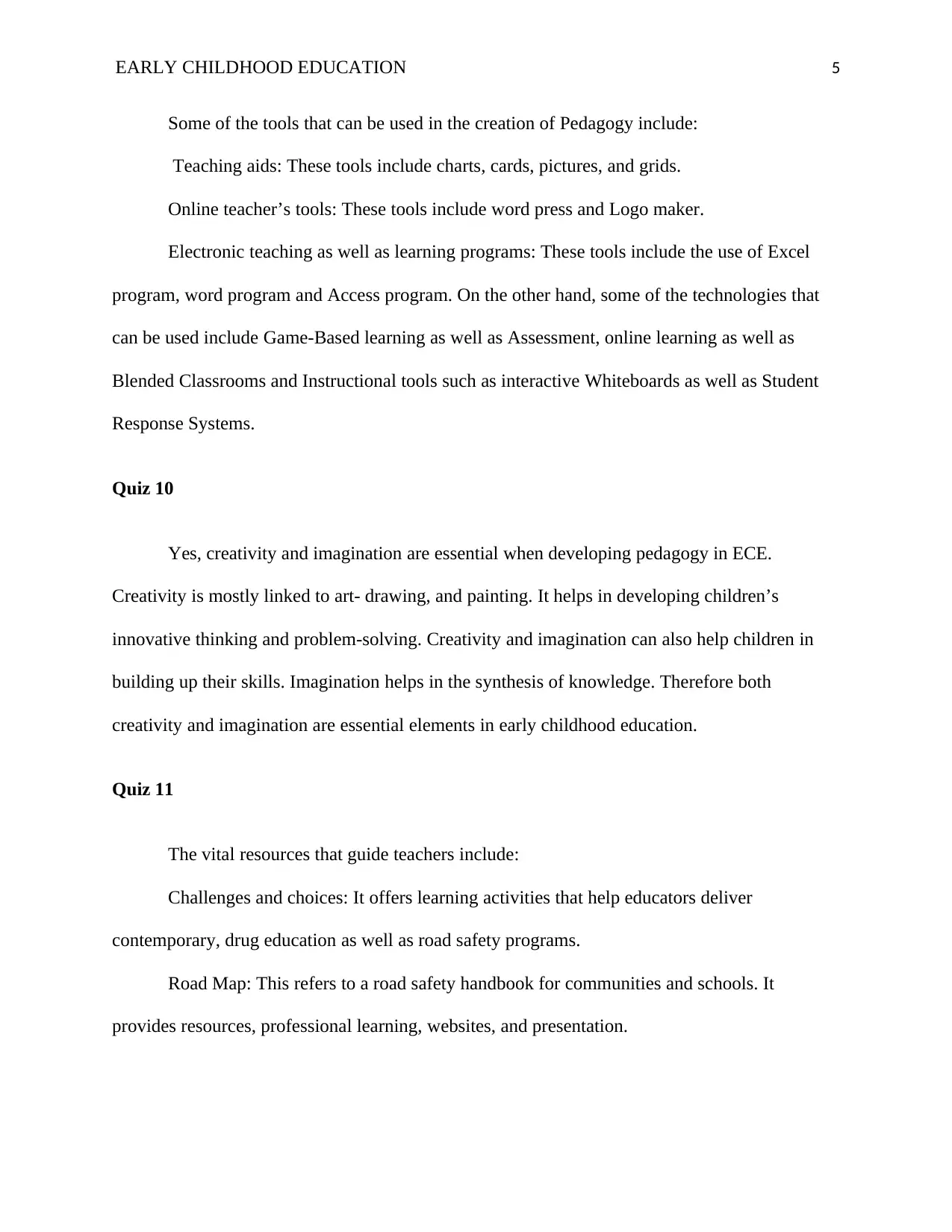
EARLY CHILDHOOD EDUCATION 5
Some of the tools that can be used in the creation of Pedagogy include:
Teaching aids: These tools include charts, cards, pictures, and grids.
Online teacher’s tools: These tools include word press and Logo maker.
Electronic teaching as well as learning programs: These tools include the use of Excel
program, word program and Access program. On the other hand, some of the technologies that
can be used include Game-Based learning as well as Assessment, online learning as well as
Blended Classrooms and Instructional tools such as interactive Whiteboards as well as Student
Response Systems.
Quiz 10
Yes, creativity and imagination are essential when developing pedagogy in ECE.
Creativity is mostly linked to art- drawing, and painting. It helps in developing children’s
innovative thinking and problem-solving. Creativity and imagination can also help children in
building up their skills. Imagination helps in the synthesis of knowledge. Therefore both
creativity and imagination are essential elements in early childhood education.
Quiz 11
The vital resources that guide teachers include:
Challenges and choices: It offers learning activities that help educators deliver
contemporary, drug education as well as road safety programs.
Road Map: This refers to a road safety handbook for communities and schools. It
provides resources, professional learning, websites, and presentation.
Some of the tools that can be used in the creation of Pedagogy include:
Teaching aids: These tools include charts, cards, pictures, and grids.
Online teacher’s tools: These tools include word press and Logo maker.
Electronic teaching as well as learning programs: These tools include the use of Excel
program, word program and Access program. On the other hand, some of the technologies that
can be used include Game-Based learning as well as Assessment, online learning as well as
Blended Classrooms and Instructional tools such as interactive Whiteboards as well as Student
Response Systems.
Quiz 10
Yes, creativity and imagination are essential when developing pedagogy in ECE.
Creativity is mostly linked to art- drawing, and painting. It helps in developing children’s
innovative thinking and problem-solving. Creativity and imagination can also help children in
building up their skills. Imagination helps in the synthesis of knowledge. Therefore both
creativity and imagination are essential elements in early childhood education.
Quiz 11
The vital resources that guide teachers include:
Challenges and choices: It offers learning activities that help educators deliver
contemporary, drug education as well as road safety programs.
Road Map: This refers to a road safety handbook for communities and schools. It
provides resources, professional learning, websites, and presentation.
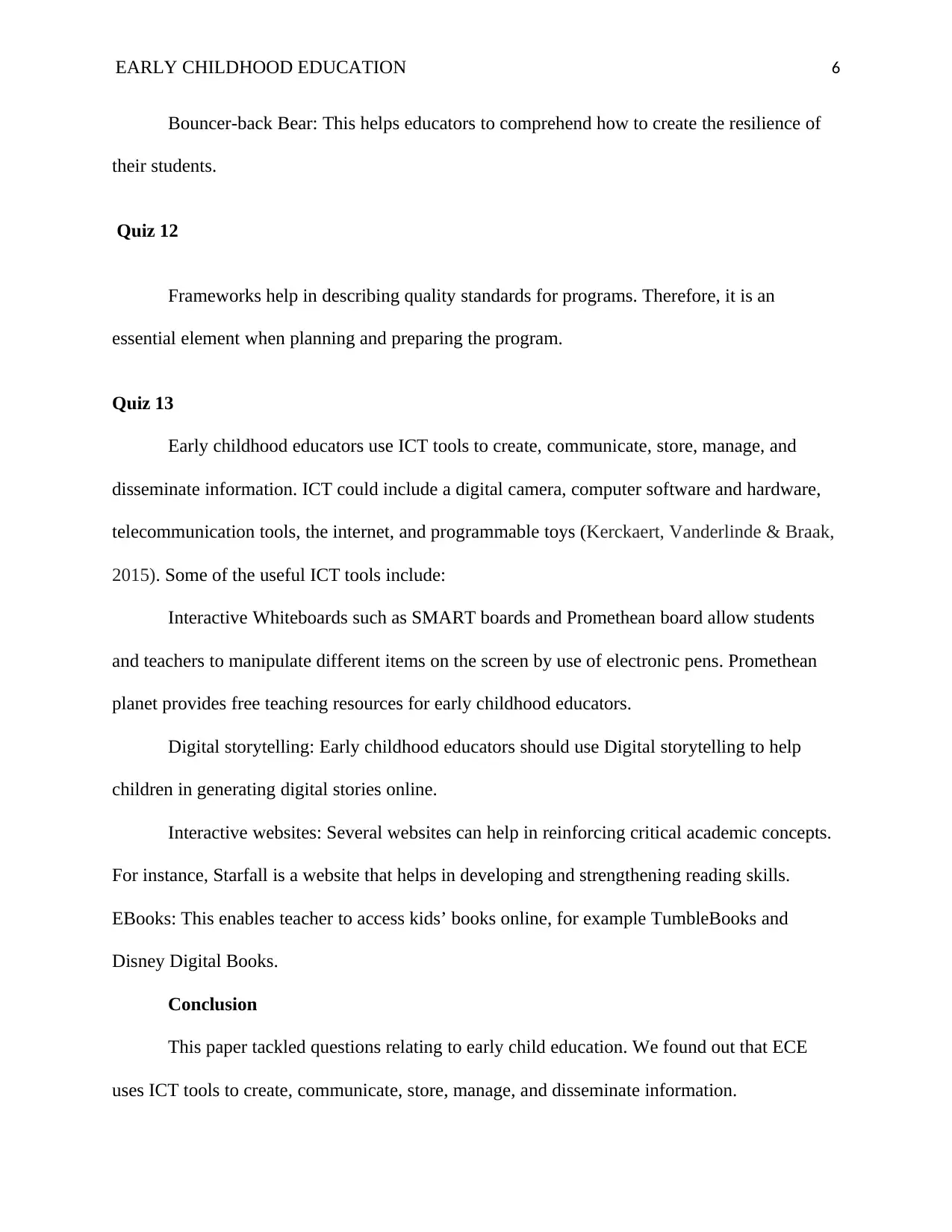
EARLY CHILDHOOD EDUCATION 6
Bouncer-back Bear: This helps educators to comprehend how to create the resilience of
their students.
Quiz 12
Frameworks help in describing quality standards for programs. Therefore, it is an
essential element when planning and preparing the program.
Quiz 13
Early childhood educators use ICT tools to create, communicate, store, manage, and
disseminate information. ICT could include a digital camera, computer software and hardware,
telecommunication tools, the internet, and programmable toys (Kerckaert, Vanderlinde & Braak,
2015). Some of the useful ICT tools include:
Interactive Whiteboards such as SMART boards and Promethean board allow students
and teachers to manipulate different items on the screen by use of electronic pens. Promethean
planet provides free teaching resources for early childhood educators.
Digital storytelling: Early childhood educators should use Digital storytelling to help
children in generating digital stories online.
Interactive websites: Several websites can help in reinforcing critical academic concepts.
For instance, Starfall is a website that helps in developing and strengthening reading skills.
EBooks: This enables teacher to access kids’ books online, for example TumbleBooks and
Disney Digital Books.
Conclusion
This paper tackled questions relating to early child education. We found out that ECE
uses ICT tools to create, communicate, store, manage, and disseminate information.
Bouncer-back Bear: This helps educators to comprehend how to create the resilience of
their students.
Quiz 12
Frameworks help in describing quality standards for programs. Therefore, it is an
essential element when planning and preparing the program.
Quiz 13
Early childhood educators use ICT tools to create, communicate, store, manage, and
disseminate information. ICT could include a digital camera, computer software and hardware,
telecommunication tools, the internet, and programmable toys (Kerckaert, Vanderlinde & Braak,
2015). Some of the useful ICT tools include:
Interactive Whiteboards such as SMART boards and Promethean board allow students
and teachers to manipulate different items on the screen by use of electronic pens. Promethean
planet provides free teaching resources for early childhood educators.
Digital storytelling: Early childhood educators should use Digital storytelling to help
children in generating digital stories online.
Interactive websites: Several websites can help in reinforcing critical academic concepts.
For instance, Starfall is a website that helps in developing and strengthening reading skills.
EBooks: This enables teacher to access kids’ books online, for example TumbleBooks and
Disney Digital Books.
Conclusion
This paper tackled questions relating to early child education. We found out that ECE
uses ICT tools to create, communicate, store, manage, and disseminate information.
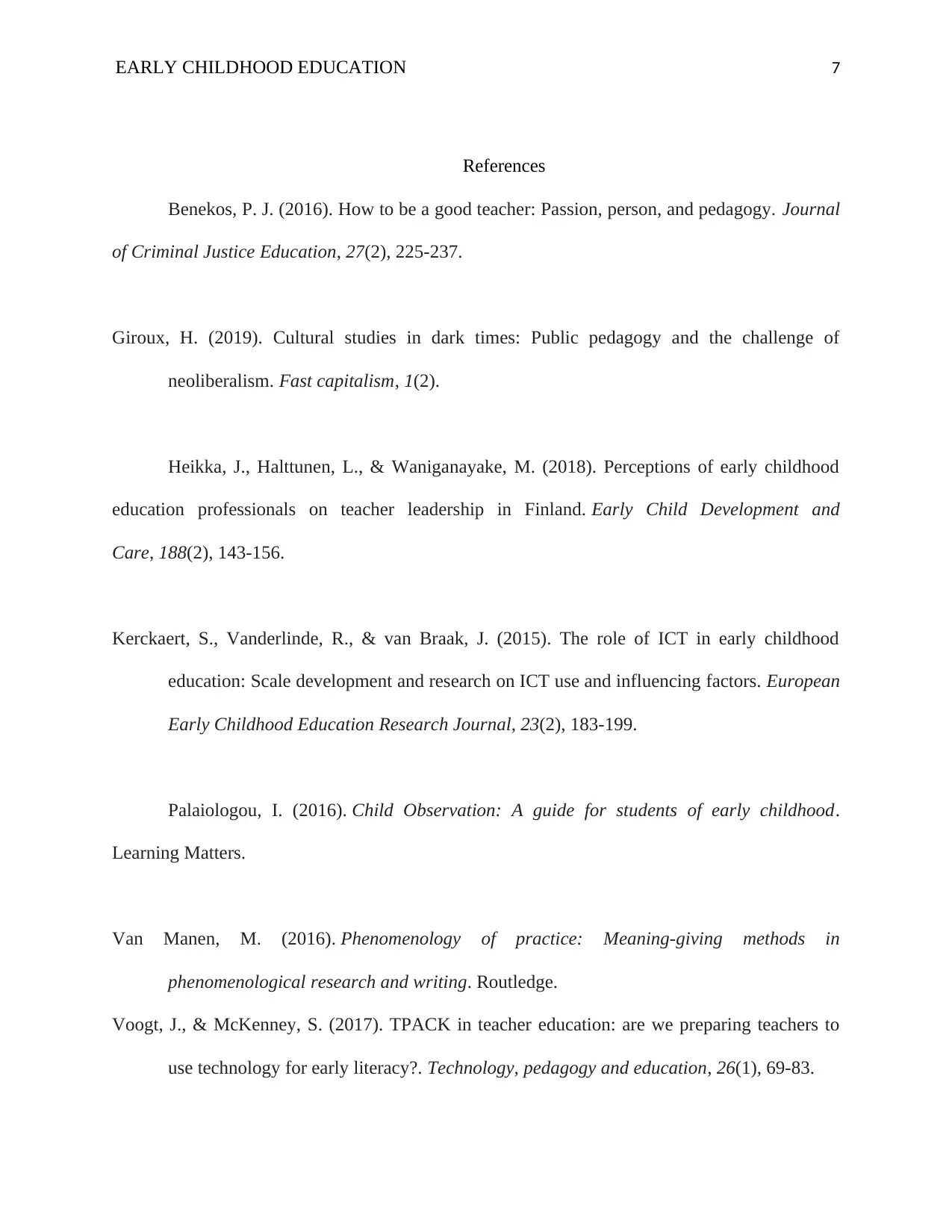
EARLY CHILDHOOD EDUCATION 7
References
Benekos, P. J. (2016). How to be a good teacher: Passion, person, and pedagogy. Journal
of Criminal Justice Education, 27(2), 225-237.
Giroux, H. (2019). Cultural studies in dark times: Public pedagogy and the challenge of
neoliberalism. Fast capitalism, 1(2).
Heikka, J., Halttunen, L., & Waniganayake, M. (2018). Perceptions of early childhood
education professionals on teacher leadership in Finland. Early Child Development and
Care, 188(2), 143-156.
Kerckaert, S., Vanderlinde, R., & van Braak, J. (2015). The role of ICT in early childhood
education: Scale development and research on ICT use and influencing factors. European
Early Childhood Education Research Journal, 23(2), 183-199.
Palaiologou, I. (2016). Child Observation: A guide for students of early childhood.
Learning Matters.
Van Manen, M. (2016). Phenomenology of practice: Meaning-giving methods in
phenomenological research and writing. Routledge.
Voogt, J., & McKenney, S. (2017). TPACK in teacher education: are we preparing teachers to
use technology for early literacy?. Technology, pedagogy and education, 26(1), 69-83.
References
Benekos, P. J. (2016). How to be a good teacher: Passion, person, and pedagogy. Journal
of Criminal Justice Education, 27(2), 225-237.
Giroux, H. (2019). Cultural studies in dark times: Public pedagogy and the challenge of
neoliberalism. Fast capitalism, 1(2).
Heikka, J., Halttunen, L., & Waniganayake, M. (2018). Perceptions of early childhood
education professionals on teacher leadership in Finland. Early Child Development and
Care, 188(2), 143-156.
Kerckaert, S., Vanderlinde, R., & van Braak, J. (2015). The role of ICT in early childhood
education: Scale development and research on ICT use and influencing factors. European
Early Childhood Education Research Journal, 23(2), 183-199.
Palaiologou, I. (2016). Child Observation: A guide for students of early childhood.
Learning Matters.
Van Manen, M. (2016). Phenomenology of practice: Meaning-giving methods in
phenomenological research and writing. Routledge.
Voogt, J., & McKenney, S. (2017). TPACK in teacher education: are we preparing teachers to
use technology for early literacy?. Technology, pedagogy and education, 26(1), 69-83.
Paraphrase This Document
Need a fresh take? Get an instant paraphrase of this document with our AI Paraphraser
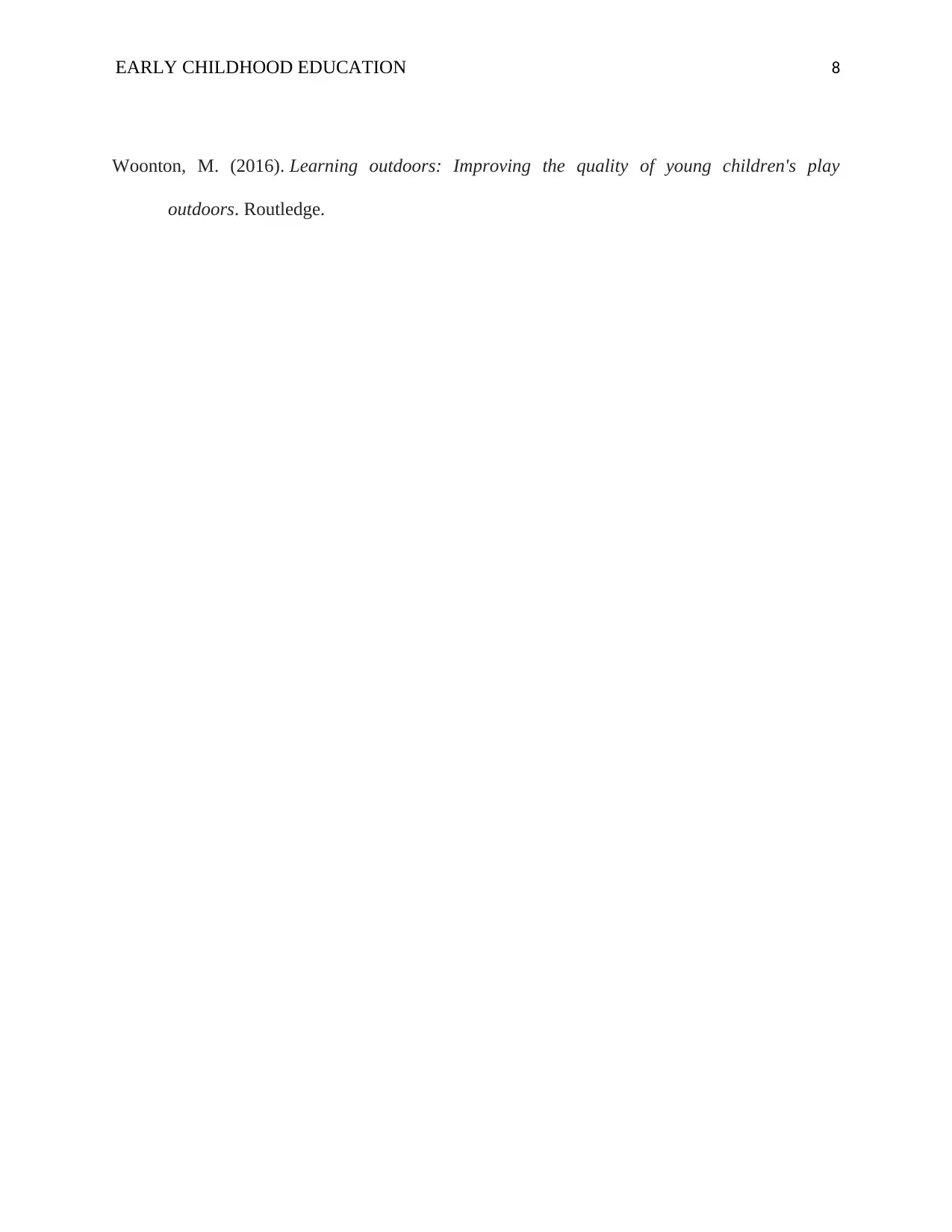
EARLY CHILDHOOD EDUCATION 8
Woonton, M. (2016). Learning outdoors: Improving the quality of young children's play
outdoors. Routledge.
Woonton, M. (2016). Learning outdoors: Improving the quality of young children's play
outdoors. Routledge.
1 out of 8
Related Documents
Your All-in-One AI-Powered Toolkit for Academic Success.
+13062052269
info@desklib.com
Available 24*7 on WhatsApp / Email
![[object Object]](/_next/static/media/star-bottom.7253800d.svg)
Unlock your academic potential
© 2024 | Zucol Services PVT LTD | All rights reserved.





